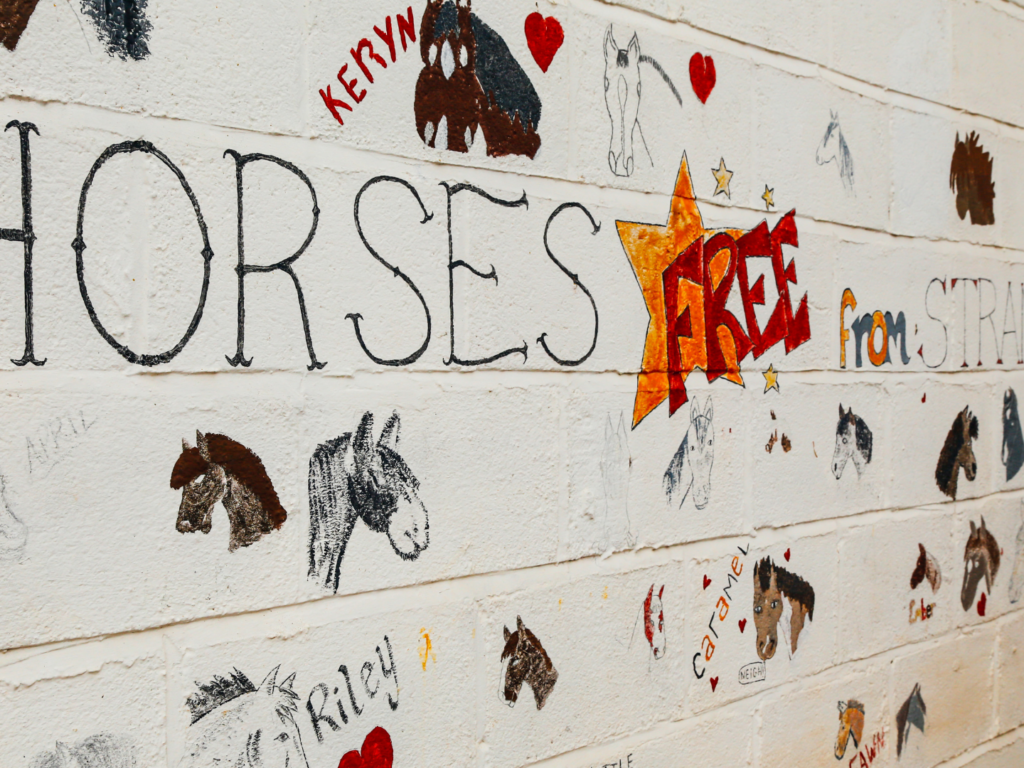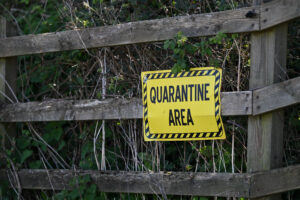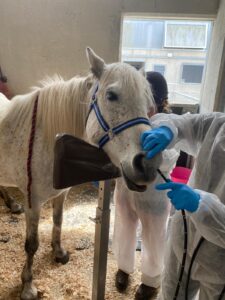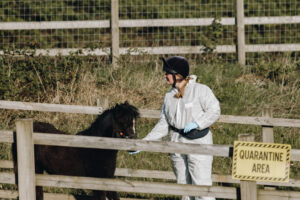
Stop the Stigma – Strangles Ten Years On
Ten years ago this month the equine respiratory infection strangles swept through our Honeysuckle rehabilitation yard in Newton Abbot, claiming the lives of four ponies and leaving many more in a critical condition.
Strangles outbreaks can be deeply emotional, exhausting and expensive. This highly contagious disease is often considered a taboo subject in the equine world, leading to fears of judgement and social isolation among horse owners. But with an estimated 600 outbreaks every year in the UK, with hundreds going unreported, we wanted to share our experience candidly, to help tackle the stigma and encourage more yards and equine owners to talk openly about the disease.
Sally, our Head of Sanctuary Care explains: ‘2015 was a devastating year for us, with the outbreak hitting in late April. We didn’t get the all-clear until October. Our team is devoted to rescuing ponies, so it was unbearable for us to watch the infection spread throughout the yard. Ten years on we still hold a special place in our hearts for those we lost, and our survivors are constant reminders of the need for us to share the valuable lessons we learned. We understand the disease far better now and we believe a no-shame approach to encourage open conversations within the equine community could help prevent more unnecessary suffering.’
What is Strangles?
Strangles is a highly contagious bacterial infection in horses caused by Streptococcus equi.
It primarily affects lymph nodes around the head, leading to swelling and abscesses that can hinder breathing and swallowing.
The disease spreads through direct contact between infected horses or indirect contact such as on clothing, equipment, hands or shared water troughs.
Maintaining good biosecurity practices is crucial to limit its spread.

What happened at The Mare and Foal Sanctuary?
It was impossible for us to confirm exactly which horse was the source of the outbreak, but in late April 2015 strangles was identified in the resident herd at Honeysuckle. All new intakes, rehoming and movement of horses across the site stopped. As a welfare charity which rescues horses with often unknown veterinary histories, quarantine had always been a priority for us. Ten years ago, we had different quarantine procedures and fewer facilities available to deal with an outbreak, with our purpose built veterinary centre not due for completion until summer 2016.
Equine Care Lead, Ellie, takes up the story: ‘We’d already learned a lot through experience of previous outbreaks, so by the time the 2015 strangles outbreak happened we thought we had a fairly good grasp of what was needed. Quarantine areas, disinfection stations and dedicated PPE were set up for the horses showing clinical signs of the disease. We split the yard into designated zones using a traffic light system. In the red zone were horses showing clinical signs of strangles, in amber, horses that had been in contact with an infected equine, and the green zone was for horses that hadn’t had any contact.
‘Back then, most of our equines came inside either by day or night. The problem was, with about 60 equines on site we were at very high capacity and were doubling-up stables, so it was hard to track which ponies had had contact with which. It also meant that there was more potential indirect contact than we would have liked. Strangles spread rapidly across the Sanctuary. In the end, around two thirds of our herd were infected, with only about twenty horses, who lived out all the time, remaining clear.’
Strangles Facts
Strangles is the most common infectious equine disease worldwide.
It can prove fatal in up to 10% of cases.
It’s not a notifiable infection in the UK. Outbreaks don’t need to be reported.
R rate: on average every equine with strangles will infect 2.2 other equines.
The infection can take up to 21 days to incubate.
Equines are not immune after getting Strangles. 75% will develop immunity for up to five years.
Equine and Human Impact
Ellie is still haunted by traumatic memories of working around the clock for seven months caring for dozens of very sick ponies. ‘I’ll never forget that feeling of utter helplessness, watching a foal grow so weak and die in our arms before the vet could get to us. All our protective instincts as equine carers were to rescue ponies and bring them to a better life, but this terrible disease was killing the most vulnerable in the herd; the young, the old, and the weak. We lost four, and it was heart wrenching. Really emotional.
‘We were exhausted, and one of the things I remember is spending hours holding hot compresses on ponies’ abscesses, just trying to comfort them. Strangles is brutal and messy and you’re trying, you’re trying so hard, and they just keep getting sicker and sicker. You feel a misplaced sense of guilt too because you’re the one who identified that there’s a problem with a pony and you report it to the vet, who then advises that due to the severity of this case, putting the pony to sleep is the kindest option. It’s necessary and the most responsible thing to do, but you’re still the one who identified the problem and that never leaves you.’
Ellie remembers there was a deep emotional and physical impact on the Sanctuary Care Team. ‘We’re a very supportive team and all of our staff stayed on to see the outbreak through, but once it was over, mentally, everyone was completely fried. Some even decided to leave equine care altogether. It affected every aspect of our lives because we often worked through the night, and not all partners and families understood. We just loved these horses and wanted to stay with them.
‘As the months passed, we kept our spirits up by creating a mural on one of the Sanctuary’s walls with drawings of our horses as they tested free of strangles. Watching the wall fill up was so positive and it made us feel there was light at the end of the tunnel. You can still see that mural at Honeysuckle now.’
Lessons Learned
Head of Sanctuary Care, Sally, says: ‘It was a relief when our normal work of rescuing, rehabilitating and rehoming horses could resume, but we knew we needed to review our quarantine protocols and reduce any chance of another outbreak spreading. Just as we all did during the Covid pandemic, our team quickly discovered through lived experience what was needed to keep our equines safe. Beech Trees, our long-planned purpose-built Veterinary and Welfare Assessment Centre was opened in 2016, with improved quarantine facilities which supported our much-needed strict biosecurity measures. We work closely with our vets to keep our own protocols up to date, and they look different now to those available to us in 2015. We’re so grateful to all our supporters who helped us to make these changes and keep us going through the outbreak. Although no equine yard is completely safe from future infection, we know that every single day we’re actively doing everything possible to limit contamination and protect our horses and ponies.

‘We’ve learned so much about the disease, collaborated in partnership education projects and are especially proud to officially collaborate in Strangles Awareness Week. It’s clear there’s a lot of misinformation being shared as fact. We used to think that if horses survived strangles, they had lifelong immunity, but that’s not true. Experts believe 75 per cent develop immunity for up to a maximum of five years.
‘As a Sanctuary we’ve transformed our strangles strategy. All new admissions are now given guttural pouch washes and nasopharyngeal washing, in place of the paired strangles ELISA tests. When it comes to detection, guttural pouch washes are best practice, and it means carrier animals are more likely to be identified before they enter the herd.’


Sharing Best Practice
Ellie says part of her learned approach is to always assume new arrivals have strangles. ‘If they come back clean, well, that’s fine. But if they come back infected, you know you’ve done everything right in taking precautions. Since 2015, a number of strangles carriers have arrived at the Sanctuary but we’ve isolated every new intake and identified them quickly through better testing. It’s a system that works.’

Strangles Awareness Week
The Mare and Foal Sanctuary is proud to be one of the partner organisations behind Strangles Awareness Week. Held in the first week of May each year, this is a collaborative campaign to raise awareness about equine strangles and promote effective preventative measures among horse owners and equestrian professionals.
Equine welfare organisations, charities, research institutes and companies work together to raise awareness about the importance of biosecurity and vaccination.
The campaign emphasises the “BEST” approach: Boost immunity by vaccinating, Engage with trusted information, Separate unfamiliar horses, Temperature check routinely. Yard owners are encouraged to become Strangles Awareness Ambassadors, promoting key messages and practices within their networks.
For more information, resources, and updates on Strangles Awareness Week, please follow our social media channels.
Possible Signs of Strangles
Dull demeanour with a temperature 38.5° or above.
Trouble swallowing & loss of appetite.
Thick nasal discharge.
Swollen lymph nodes around the head.
Abscesses on lymph nodes.
Difficulty breathing and a cough.


